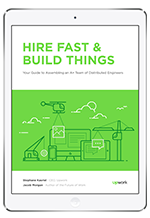
Agile vs. Waterfall—if you’re at least a little familiar with the world of software development, then you’re probably already well acquainted with the heated discussions this topic can generate.
On one side, there’s the Waterfall method, which follows a straight line from the start of a project to its completion. On the other side is Agile, a more flexible and team-focused way of developing software in cycles. Both aim to make software development projects more efficient, but they do it differently. So, what sets these two methods apart? And what are the benefits and drawbacks of each?
In this article, we’ll try to give a fair and balanced representation of each process so that you can decide whether Agile or Waterfall is best for your project.
The Waterfall Method
The Waterfall method is the traditional approach to software development where a project is broken up into distinct stages that must be completed in sequence.
The name reflects its process: each stage represents a specific part of software development, and you have to finish one phase before moving on to the next. In a strict Waterfall approach, going back to a previous phase is not allowed—you can only move forward and must finish the entire development cycle before starting over. Additionally, there is usually a review of requirements at the end of each stage.
The number of stages in Waterfall vary across organizations, but the general approach might look something like this:
- Conception: The first phase of the systems development life cycle (SDLC) starts with an idea, evolves into a cost/benefit analysis, and ends with a rough estimate of the scope of the project.
- Initiation: The second phase involves hiring the project team and expanding upon the project scope with objectives, purpose, and deliverables.
- Analysis: A feasibility analysis is conducted by looking at the scope of the project and gathering all the requirements into a requirement specification document.
- Design: Mockups, wireframes, and storyboards—in this phase, the designers put a face to the project. Requirements are reviewed and evaluated, team goals are set, and a plan of action is developed.
- Coding: The developers start building the actual app based on flowcharts, mockups, and designs created in the previous phase.
- Testing: The completed product undergoes testing to work out all the kinks. This stage may involve extra coding to resolve any issues within the source code, as well as user acceptance testing (UAT) where users vet the software prior to launch.
- Production/Implementation: The product is launched into the market.
- Maintenance: Users will inevitably run into bugs, and the development team will need to stand ready to resolve any issues with a patch. Patches can also be used to add new features to remain competitive.
You’ll notice that this is basically the standard SDLC broken out as separate phases of development. Now let’s look at some advantages and disadvantages of this approach.
Pros of Waterfall
- Clear deadlines: Waterfall’s static nature and predictable workflow make it easy to estimate costs, create timelines, and stick to deadlines.
- Disciplined by design: Since each phase has a clear start point and a requirement review gate at the end of it, the team is forced to complete all tasks before the project as a whole can proceed.
- Well-documented: Waterfall requires documentation and a clear paper trail for each phase of development. This makes it easier to follow the logic of past projects and lay the groundwork for future projects.
- Clear communication: Predictable timelines and well-documented projects make it easy to give status updates to upper management, stakeholders, or clients with strict requirements.
- Easy learning curve: As the traditional approach to project management across industries, teams usually don’t require any prior knowledge or training in order to start working on a project with the Waterfall method.
Cons of Waterfall
- Change can be costly: The major downside to Waterfall’s rigidity is the hampered ability to handle change. Testing occurs late in the project life cycle, and if you find out that your end users don’t like the product you’re building, it can be too late to pivot.
- Slow delivery times: As many as four phases of development need to be completed before any coding begins—which means stakeholders and customers won’t see a working product until late in the life cycle.
- Gathering requirements too early is risky: Customers and stakeholders often don’t know what they really want until they’ve had a chance to play with a working prototype. Since Waterfall handles all the requirement gathering upfront, there’s a real risk of missing the mark and causing further headaches down the project line.
- Tendency to neglect testing: Saving all the testing for the end of a project can be risky, because of the temptation to rush through it when there’s a looming deadline. A poorly tested product can lead to a disastrous launch. You also lose out on valuable data you could have gained earlier in the project.
The Agile Way
Agile takes an iterative approach to software development. Instead of handling all the planning upfront, Agile focuses on being lean and producing minimum viable products (MVPs) over set periods of time while improving with each iteration.
The different phases of the development cycle can happen in parallel and a backlog is kept to keep track of desired features and requirements. Agile methodologies place an emphasis on teamwork, constant user feedback, continuous improvement, and the ability to adapt to changing requirements. Agile is a broad term that refers to any methodology that abides by the Agile Manifesto established on February 17, 2001.
We’ve listed a few of the more popular implementations below:
- Scrum: One of the most popular ways to do things the Agile way, the Scrum framework defines uniform roles, responsibilities, and meetings that provide critical stability in an otherwise dynamic project development methodology. Scrum is known for its fast-paced Sprints in which an MVP is delivered every one to two weeks.
- Kanban: The Japanese word for “visual sign” or “card,” Kanban helps more traditional organizations improve their processes by visualizing their workflow, limiting work in progress (WIP), and enhancing the flow of backlogged items.
- Extreme Programming (XP): XP emphasizes high software quality and responsiveness to changing customer requirements. Pair programming, extensive code reviews, and unit tests characterize this Agile methodology.
- Adaptive System Development (ASD): ASD is best known for its repeating three-phase development cycle—speculate, collaborate, and learn.
- Feature-Driven Development (FDD): FDD is a lightweight Agile methodology that blends a number of industry best practices together into a five-step development cycle—develop the overall model, plan by feature, design by feature, and build by feature.
Pros of Agile
- Adaptability: The short development cycles of the iterative design process give the project the flexibility to pivot when it needs to.
- Immediate user feedback: The emphasis on getting shippable products into the hands of users means the project is guided by the market. This reduces the risk of building an app that nobody wants while increasing the chances you’ll find that killer feature that will sell your product earlier in the project life cycle.
- Test-driven development (TDD): The beauty of breaking a project into manageable chunks is that there is enough time to write unit tests for the few features that made the cut for the MVP.
- Fast, high-quality delivery: TDD at each iteration leads to fewer bugs and higher-quality releases. A solid foundation leads to quicker, higher-quality releases with successive iterations.
- Teamwork: Agile methodologies place an emphasis on frequent communication and face-to-face interactions. Teams work together, benefit from pair programming, and interface daily with business development.
Cons of Agile
- Nebulous timelines: With all of its advantages, Agile’s flexibility can also easily leave the door open to procrastination. Since tasks are often being reprioritized and generated with every iteration, the overall timeline can seem to stretch into infinity.
- Skill-dependant teams: Agile was designed for small multidisciplinary teams. Oftentimes, that translates to only one person per role (i.e., the designer). The relative lack of structure when compared with Waterfall means that each member must be self-disciplined and proficient in their role.
- High time commitment: Agile works best when everyone is committed to the project. This is especially true for Agile because much of the methodology is focused on active team involvement and face-to-face collaboration, which can be more time-consuming than the traditional approach.
- Tendency to neglect documentation: The Agile Manifesto emphasizes working software over comprehensive documentation. This is normally a good thing, but depending on the project, Agile teams will have to strike the right balance between code and documentation.
Choose the Right Project Development Methodology for Your Needs
By now you’ve probably realized that when it comes to managing a project, both Waterfall and Agile are viable project development methodologies that can help you get organized and build high-quality products. The choice between Agile and Waterfall can best be summed up in two words: flexibility vs. stability.
You Should Use Agile If…
You’re building a new product in an uncertain world and you have a real need for speed. If you don’t have a lot of information up front, enforcing strict requirements and planning at the beginning of your project can lead to costly mistakes further down the line. Agile was designed to reduce the cost of change and uncertainty—which is why it’s no surprise that many startups swear by the methodology. Agile excels when you don’t have a clear picture of the end goal and requirements are constantly changing.
You Should Use Waterfall If…
Your client knows exactly what they want, and you’re very confident that there won’t be any major changes in scope throughout the project. Waterfall works great for building software for clients who have clearly defined requirements that aren’t likely to change throughout the life cycle of your project—think government contracts or legacy systems. When projects are simple and predictable, you can benefit from Waterfall’s inherent stability and linear development path.

